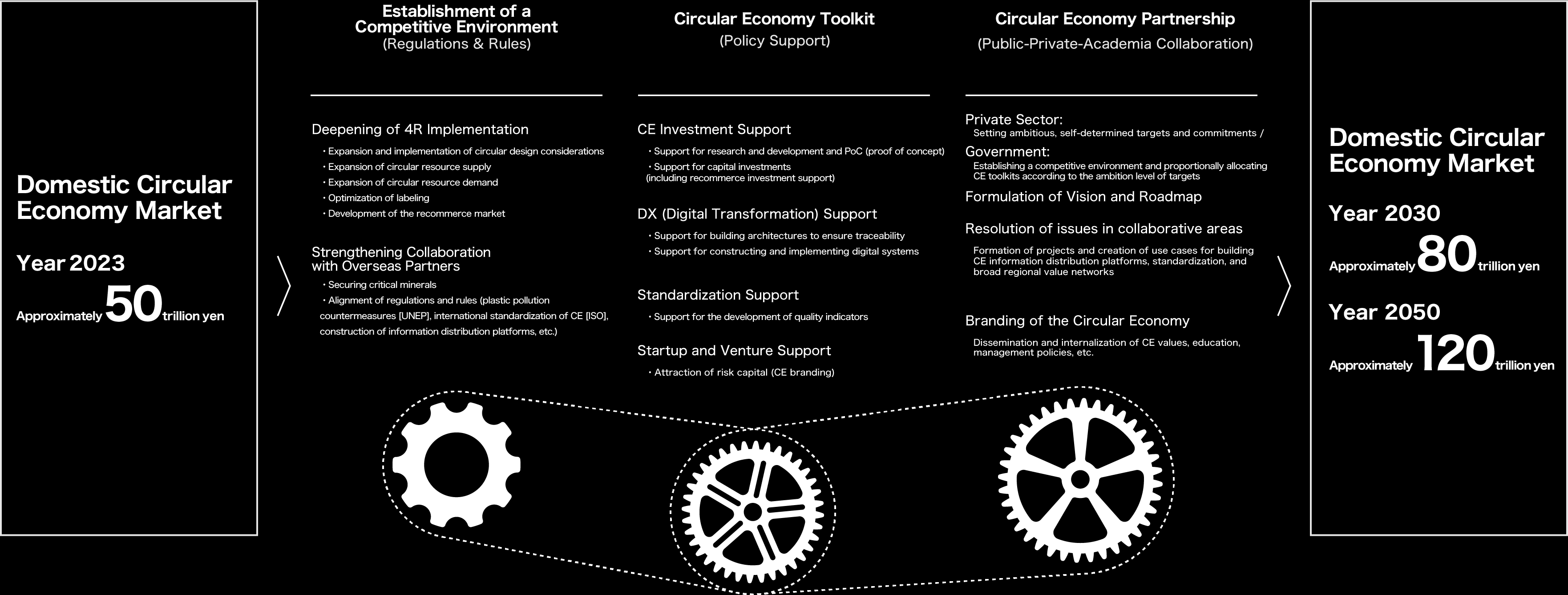What is a Growth-Oriented Resource Autonomous Economy?
In the “Circular Economy Vision 2020,” formulated by the Ministry of Economy, Trade and Industry in May 2020, the 3Rs (Reduce, Reuse, Recycle) are no longer viewed solely as measures for waste and environmental protection, but rather as a new business opportunity that leads to a “virtuous cycle of the environment and growth.” It was presented as the fundamental direction of Japan’s circular economy policy that Japanese companies should leverage the strengths they have cultivated through their 3R initiatives in the global market to enhance medium- to long-term industrial competitiveness.
And in March 2023, the “Growth-Oriented Resource Autonomous Economic Strategy” was formulated to control supply risks for goods and resources amid global circumstances, thereby leading to the autonomy and resilience of the economy and the acquisition of international competitiveness.
Underlying Awareness of the Issues
資源制約・リスク
Resources Risk
- Global increase in material demand:
- Many materials are at risk of depletion in the future (especially gold, silver, copper, lead, tin, etc., where cumulative demand by 2050 is more than double the existing reserves)
- Certain materials have supply concentrated in only a few countries:
- Risk of supply disruption due to resource-rich countries’ policies (some materials with particularly high concentration include nickel, manganese, cobalt, chromium)
- Japan is a “resource-poor country” heavily dependent on imports of many resources:
- Concerns over increased procurement risk as Japan’s purchasing power for resources declines
Global resource extraction volume

環境制約・リスク
Environmental Risk
- Increasing difficulty of waste disposal:
- Global tightening of cross-border restrictions on waste movement (Basel Convention), while Japan faces limitations on final disposal sites
- Necessity of responding to carbon neutrality:
- Reduction of CO₂ emissions by raw material industries is essential
Global waste volume

成長機会
Growth Opportunity
- Potential for a substantial expansion of the circular economy market:
- Downstream industries are expected to become major growth industries, leading to an inflow of growth capital into the circular economy market
- If the transition to a resource autonomous economy is delayed, there is a possibility of significant economic loss:
- Concerns about outflow of national wealth due to increased material imports and soaring resource prices, as well as the exclusion from the market of products that do not guarantee circular economy traits
Scale of the circular economy-related market: Global

A Growing Circular Economy-Related Market
The circular economy-related market is expected to expand significantly in the future, reaching 4.5 trillion dollars globally by 2030 and 25 trillion dollars by 2050, and 80 trillion yen by 2030 and 120 trillion yen by 2050 in Japan. While countries around the world are each aiming to capture this market in their own ways, Japan has also begun taking actions toward realizing the “Growth-Oriented Resource Autonomous Economic Strategy.” Over the next decade, Japan aims to create markets through measures such as reviewing institutional frameworks and implementing structural reforms to accelerate collaboration between upstream and downstream industries, as well as supporting Green Transformation (GX) investments.
EU
Aiming to build a circular economic sphere through regulatory measures
- Exclusion of products that do not comply with regulations
- Enclosing recyclable resources within the region
- Global standardization of regional standards and rules
United States
De Facto Standardization Through Competition Among Leading Companies
- Elimination of Materials Not Aligned with Procurement Policies
- Enclosing recyclable resources within the region
- De Facto Standardization in Finance
Japan
Accelerating the marketization of the Circular Economy through "Three Gears" of policy measures, with an investment of approximately 2 trillion yen over the next 10 years.
- Regulations & Rules: Reviewing institutional frameworks to accelerate arterial and venous industrial collaboration.
- Policy Support: Implementing approximately 2 trillion yen in investment over the next 10 years.
- Industry-Government-Academia Collaboration: Discussing necessary policies for realizing the Japanese version of the Circular Economy.
Transmission for Establishing a Growth-Oriented Resource Autonomous Economy: Three Gears

Based on the "Growth-Oriented Resource Autonomous Economy Strategy Reference Material" (March 2023, Industrial Science and Technology Environment Bureau, Ministry of Economy, Trade and Industry), created by the council.